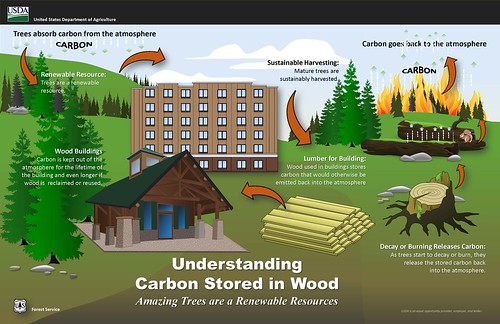
Forests and wood products are powerful tools to help mitigate the impacts of climate change. (Click to view a larger version)
Trees do plenty of work to sequester carbon on their own, but many forests are not as healthy as they should be due to fire suppression and climate change. This can leave trees vulnerable to large scale insect damage, fire or drought, and much of the carbon stored by forests is lost to the atmosphere as trees die.
The U.S. Forest Service is committed to the storage of carbon using wood products through the green building and wood products strategy. This strategy involves putting people to work in rural communities, enhancing resiliency of our ecosystems, and sequestering carbon by promoting the use of wood products in large building construction.
By using wood instead of, or along with, concrete and steel, large amounts of carbon can be stored in the walls of homes and offices, significantly reducing emissions associated with the production of other materials. Also, using sustainable timber harvests for emerging wood product technologies like cross-laminated timber, can stimulate local economies in timber country while sequestering carbon in long-term wood products.
Cross laminated timber is a wood panel made of layers of dried lumber boards stacked in alternating directions, glued and pressed to form solid panels. These panels have extraordinary strength and are being used as walls, roofs, and floors. D.R. Johnson Mill in Riddle, Oregon announced recently that it will be the first U.S. mill certified to produce cross-laminated timber for high rise construction.
Putting our own green building strategy to work, the Forest Service is working to increase the use of locally milled timber in all new agency buildings and facilities. Since 2011, we have used wood to build the Angeles National Forest Supervisor’s Office, Camino Real Ranger Station, Corvallis Laboratory, Juneau Laboratory, and Enomee Ranger District Office.
And in the private sector projects like the Bullitt Center in Seattle are showcasing the use of sustainable, Forest Stewardship Council certified wood products to efficiently create new buildings that will last and become testaments to sustainable forest management. The Bullitt Center sequesters 1,703 metric tons of carbon in its walls.
The trees in our national forests can help mitigate the effects of climate change in so many ways, and the Forest Service is committed to helping neighboring communities by promoting sustainable development with trees and wood.
No comments:
Post a Comment
Note: Only a member of this blog may post a comment.